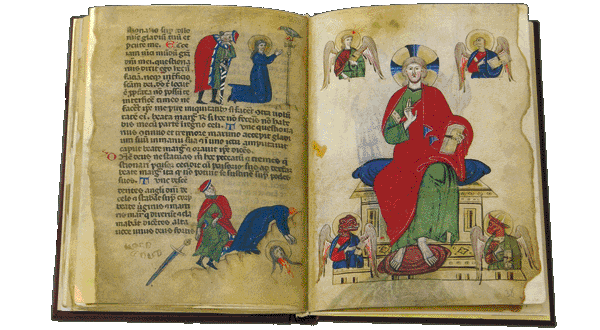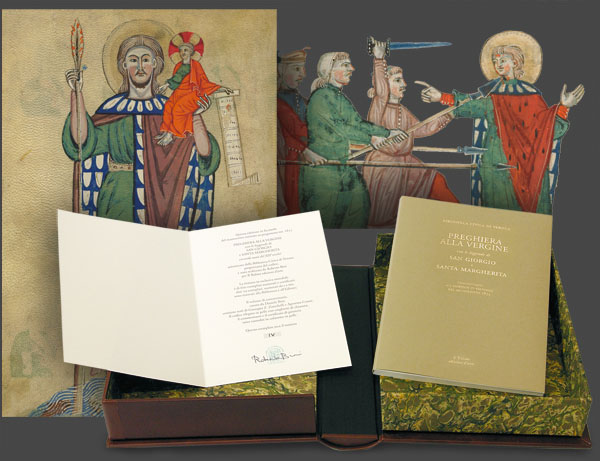  

  
illuminated manuscript
XIII century
41 folios cm 17x24
ISBN 88-86251-66-1
Price: € 3.600,00
|
|
PRAYER TO THE VIRGIN
and legends of St. George and St. Margaret

The manuscript 1853 of the Biblioteca Civica in Verona is a parchment illuminated codex, realized during the second half of the 13th century. Its average size is 17 × 24 cm and it is made up of 42 sheets (i.e. 84 pages). The first 2, written in semi-cursive Gothic, contain the Prayer to the Virgin, one of the most ancient lauds in Veronese vulgar. The rest of the manuscript, fully illustrated, presents 2 texts written in rotunda Gothic: the legends of St.George of Cappadocia (ff. 3r-26r) and of St.Margaret of Antioch (ff. 27r-37v). In the end of the codex two full-page illuminations portray Christ almighty with the four evangelists and St. Christopher.
The manuscript was bought by the Biblioteca Civica in 1881 for 200 lire of the time. In a document its provenience is written to be from the convent of St. Mary Magdalene which, since 1350, ruled the Franciscan one of St.Mary of the Virgins. The latter hosted, between the 13th and the 14th century, many young girls of the Veronese aristocracy, included one from the ruling family Della Scala, to whom the monastic life was imposed. This has led scholars to suppose that the manuscript, meant to foster the achievement of a life of deep spirituality, followed a young noblewoman in her life in the convent.
An extraordinary story in images
The artistic importance of the manuscript is due to the 78 extraordinary miniatures that illustrate the legends of St.George and St.Margaret.
The result is a wonderful narration in images, the peculiarity of which is the continuous relation between text and illustrations. On the one hand this confirms one of the characteristics of medieval miniature – especially in religious and liturgical manuscripts, also because of the necessity of a direct and straight comprehension of God’s message –; on the other hand, all the illuminations, perfectly preserved, stand out for the unusual and incomparable amplitude, for the connections in style with frescoes of the same period in Verona and for the evident influence of Bolognese painting.
Legend of St.George
A good 55 miniatures illustrate the legend of the tribune George of Cappadocia, from the moment in which he announces his Christian faith to the emperor Dacianus to his beheading, after 7 years of tortures. The final image of the legend is the most famous one: St.George riding transfixes with his lance the dragon that a princess keeps on a leash. Later, around 1435, Pisanello would paint the same scene on his fresco for the church of St. Anastasia in Verona.
Legend of St. Margaret
Twenty-one miniatures decorate the legend of St. Margaret, young shepherdess in Antioch with whom Olibrius, Roman governor, becomes infatuated. The refusal of the girl is considered an act of rebellion against the power of the Roman emperor and therefore she is savagely tortured and sentenced to death. The story of the Saint has always been one of the favorite subjects in Christian art, both in the East (10th century frescos in the churches of Goreme, in Cappadocia) and the West (the well-known painting of Tiziano, dated 1550).
The facsimile edition
The edition, authorized by the Biblioteca Civica of Verona, is printed on a specific paper; each folio is punched following the edges of the original manuscript. The binding is made of wooden boards covered with red leather with straps and clasps.
The commentary volume, edited by Daniele Bini, presents the complete transcription of the text and essays by Agostino Contò and Giuseppa Z. Zanichelli.

|
|




